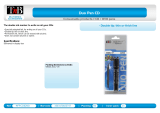
2
Copyright Notice
All rights reserved. No part of this publication may be reproduced, stored in a retrieval system, or transmitted in
any form or by any means, electronic, mechanical, photocopying, recording, or otherwise, without the prior
written permission of SEIKO EPSON CORPORATION. The information contained herein is designed only for
use with this Epson printer. Epson is not responsible for any use of this information as applied to other printers.
Neither SEIKO EPSON CORPORATION nor its affiliates shall be liable to the purchaser of this product or third
parties for damages, losses, costs, or expenses incurred by purchaser or third parties as a result of: accident, misuse,
or abuse of this product or unauthorized modifications, repairs, or alterations to this product, or (excluding the
U.S.) failure to strictly comply with SEIKO EPSON CORPORATION’s operating and maintenance instructions.
SEIKO EPSON CORPORATION shall not be liable for any damages or problems arising from the use of any
options or any consumable products other than those designated as Original Epson Products or Epson Approved
Products by SEIKO EPSON CORPORATION.
A Note Concerning Responsible Use of Copyrighted Materials
Ink jet printers, digital cameras, and scanners, like photocopiers and conventional cameras, can be misused by
improper copying and reprinting of copyrighted material. While some countries’ laws permit limited copying of
copyrighted material in certain circumstances, those circumstances may not be as broad as some people assume.
Epson encourages each user to be responsible and respectful of the copyright laws when using ink jet printers,
digital cameras, and scanners.
Trademarks
Epson, Epson Stylus, and MicroWeave are registered trademarks and PRINT Image Matching is a trademark of
SEIKO EPSON CORPORATION.
UltraChrome, Hi-Gloss, BorderFree, PremierArt, PhotoEnhance, and Epson Software are trademarks, and Epson
PhotoCenter, Epson Store, SoundAdvice, and Epson Connection are service marks of Epson America, Inc.
General Notice: Other product names used herein are for identification purposes only and may be trademarks of
their respective owners. Epson disclaims any and all rights in those marks.
The E
NERGY STAR emblem does not represent EPA endorsement of any product or service.
© 2004 Epson America, Inc. 02/04 CPD-17409R1
4047569-00





















